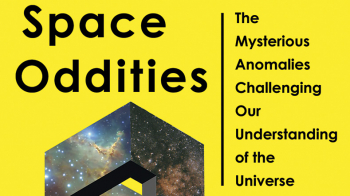Collision – Stories from the Science of CERN, edited by Rob Appleby and Connie Potter, Comma Press
Collision – Stories from the Science of CERN is a highly readable anthology built on the idea of teaming up great writers with great scientists. There are 13 stories in all, each accompanied by an afterword from a member of the particle physics community. The authors are a very diverse bunch, so there’s something for everyone – from exploring the nature of symmetry through the mirror of human interaction, to imagined historical encounters and, inevitably, the apocalyptic: we humans have always ventured into the unknown with trepidation.
Being of the same vintage as the BBC’s Dr Who, I was pleased to discover that the first story was penned by one of the programme’s most successful showrunners, Steven Moffat. Although I found myself doubting the direction of travel after the opening paragraphs, I enjoyed the destination. It was a good start, and it established a standard that the book maintains to the very last word.

In Adam Marek’s story, I found myself listening along to protagonist Brody Maitland’s selection of music for his appearance on BBC Radio 4’s Desert Island Disks, something of a national institution in the UK. This story also contains the wonderful line: “we live in a world where it is more impressive to have millions of followers than to lift the stone of the universe and reveal the deep mysteries scurrying beneath it.” How true that is in a world of diminishing attentions spans.
Broadcaster and journalist Bidisha Mamata provides a welcome commentary on contemporary global politics. An unscrupulous leader manipulates an ambitious individual in a bid to undermine the global order. Sound familiar? In this case, the individual concerned is a CERN scientist, the reputation at stake, CERN’s, and the tool to achieving that goal the creation of a locally apocalyptic event. Politically spot on. Scientifically wide of the mark.
Post-apocalyptic scenarios make other appearances, though in these cases it’s what happens next that’s important. Stephen Baxter’s AI protagonist guides us through millennia of human stupidity, while Lillian Weezer imagines what might happen if people unearthed the LHC in some post-apocalyptic world.
Prometheus and Frankenstein make their appearances in Margaret Drabble’s wonderfully erudite tale set at CERN in the 2050s. Desiree Reynolds imagines a delicious encounter that never happened between CERN’s first Director General, Felix Bloch, and the American writer and civil rights activist James Baldwin. Would they have gelled? I’d like to think so. There’s a cautionary tale from Courttia Newland about AI, which draws the conclusion that whatever form intelligence may take, life, of a kind, will go on and the laws of the universe will remain the same. Ian Watson’s joyous facility with words puts a smile on your face from the first line of his galaxy-skipping parable. You’ll have to read it for yourself to find out whether he leaves you smiling at the end.
A recurring theme is the parallel between life and physics: Poet Lisa luxx, for example, entwines forces at work in nature with those between people, while Lucy Caldwell examines notions of uncertainty in life and physics in a story set in her native city Belfast. Peter Kalu applies a similar principle to computer security, with a cautionary yet warming tale about a side-channel attack of sorts.
Enough of the stories, what about the afterwords? Peter Dong’s comment leaves you wanting to sit in on his physics classes, while Jens Vigen gives a thoughtful account of the origins of CERN. Kirstin Lohwasser does a fine job of bringing Bidisha’s science back to the realms of reality. Tessa Charles is bullish about the FCC, currently at the feasibility stage. Michael Davis gives a glimpse of the vast industry that is modern day computer security.
Anyone that has juggled particle physics and parenting will identify with Luan Goldie’s story, which is accompanied by a heartfelt paean to CERN by one who has done just that. “Life is work and work is life,” says Carole Weydert, concluding with the words: “CERN. Grey. But sparkling.”
Andrea Bersani introduces us to the speculations that distorted spacetime allow, while Andrea Giammanco does a similar job for the dark sector. Daniel Cervenkov discusses CP violation, while Joe Haley ponders the development of ideas over time: Newton subsumed by Einstein, the Standard Model by something yet to be found. Gino Isidori, for his part, takes us on a brief guided tour of a metastable universe. John Ellis’s pairing with Stephen Baxter is particularly successful. The writer’s central story, which spans millennia and civilisations resonates well with the theoretical physicist’s daily work of examining Gauguin’s questions: “D’où venons nous, Que sommes nous, Où allons nous.”
All in all, the book makes for a varied, thought provoking and engaging read. As with the Arts at CERN programme, it demonstrates that creativity is not the preserve of the arts or of science, and that great things can happen when the two collide.
If you enjoy the book, then you might also like to explore some of the history of CERN’s engagement with the arts, from James Lee Byars’s visit to the lab in the 1970s to the Signatures of the Invisible project in 1999, or poetry produced for the European Researchers’ night in 2014.








